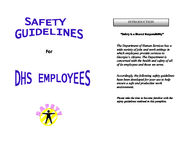For
INTRODUCTION
"Safety is a Shared Responsibility"
The Department of Human Services has a wide variety of jobs and work settings in which employees provide services to Georgia's citizens. The Department is concerned with the health and safety of all of its employees and those we serve.
Accordingly, the following safety guidelines have been developed for your use to help ensure a safe and productive work environment.
Please take the time to become familiar with the safety guidelines outlined in this pamphlet.
GENERAL SAFETY PRACTICES
As a DHS employee, you should become "safety conscious." Please observe the following safety practices at all time which on the job.
o Know and follow all safety rules and practices of DHS.
o Report acts or threatened acts of violence in the work place.
o Immediately bring any potentially unsafe or unhealthful working condition to the attention of your supervisor.
o Report all work-related injuries and/or illnesses, however minor they may seem, to your supervisor when they occur.
o Be free of alcohol and drugs. o Wear proper protective equipment and clothing at
all times. o Maintain safe housekeeping practices. o If you are unsure about the safety guidelines
regarding any responsibility or duty, please ask your supervisor.
LIFTING, STRAINS & SPRAINS
Many accidents occur because of poor planning. When a job requires lifting and moving items from one location to another, stop and think about the easiest and safest way to complete the task. Taking the time to think ahead will help prevent problems later.
o Think before you lift. o Use proper lifting techniques. o Do not lift more than 50 lbs. per person get
help when needed. o Spread your feet 8 to 12 inches apart, with one
foot slightly in front of the other. o Keep your feet close to the item. o Lift using leg muscles instead of your back.
Keep the item close to you. o Do not twist your body. If you have to change
direction, turn your feet. o If you have to reach for something, move
closer to the object if possible.
SLIPS, TRIPS & FALLS
Many slips, trips and falls can be avoided by just being aware of your work environment. Common sense, knowledge of potential problems and taking some simple precautions can prevent most accidents from occurring.
o Wear slip resistant and/or steel-toe shoes. o Clean up spills immediately. o Handle potentially dangerous items carefully. o Keep floors and aisles clear of clutter. o Do not carry loads that block your vision. o Walk do not run. o In case of ice or snow, use caution when walking
(e.g., on sidewalks and across parking lots) and climbing stairs.
CUTS / NEEDLE STICKS
On some jobs, you may be required to use sharp instruments, such as: needles, knives, scissors, box cutters, etc. As with any sharp tool, extra care will help prevent painful and/or potentially dangerous injuries.
o Wear gloves and other protective clothing when necessary or required.
o Use only approved safety knives with sharp blades.
o Keep your free hand away from knives. o Make sure the object to be cut in a steady position. o Cut away from your body. o Concentrate on the job. o If necessary, ask for assistance from other staff
when using a sharp tool (e.g., needle). o When using needles, follow the specific safety
procedures of your work unit. o Place used needles in puncture-resistant
receptacles. o Immediately report any needle sticks to your
supervisor.
FIRE SAFETY
It is everyone's responsibility to ensure that fire safety is observed.
o Be familiar with the locations of fire exits and extinguishers.
o Know the fire emergency plan and emergency coordinators.
o If a fire starts, report it immediately to the emergency coordinator, appropriate officials, or call 911.
o Evacuate the area, if appropriate. o Never try to fight a fire that is spreading or
threatens to block your escape.
HAZARDOUS CHEMICALS
At some work locations, potentially hazardous chemicals may be used. Many chemicals are dangerous and harmful to the environment if not properly handled.
o Read the instructions on all chemicals before using.
o Use protective equipment gloves, masks, goggles, boots, etc.
o Notify your supervisors of any accidents or spills.
INJURY / ILLNESS PROCEDURE
It is everyone's responsibility to prevent work-related injuries and illnesses whenever possible. Work-related injuries and illnesses do, however, sometimes occur regardless of our best intentions to prevent them. In the event of a work-related injury and/or illness, you should be prepared to act quickly.
Procedures to follow regarding work-related injuries and/or illnesses:
o Report ALL work-related injuries and/or illnesses immediately to your supervisor.
o Seek appropriate medical treatment, when necessary. Treatment must be received from a physician listed on the "OFFICIAL NOTICE" that is posted at your work site, unless an emergency situation exists.
o In the event of an emergency, seek immediate assistance (e.g., emergency room, call 911).
o Keep your supervisor informed of the status of your injury and/or illness.
o Work cooperatively with your supervisor and others to return to work as quickly and safely as possible.
If you have questions regarding information in the pamphlet, please talk with your supervisor, human resources/personnel representative of the Office of Human Resource Management and Development (OHRMD).
*****************
Prepared by the Office of Human Resource Management and Development
March 17, 2011
